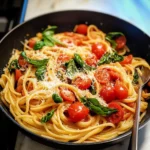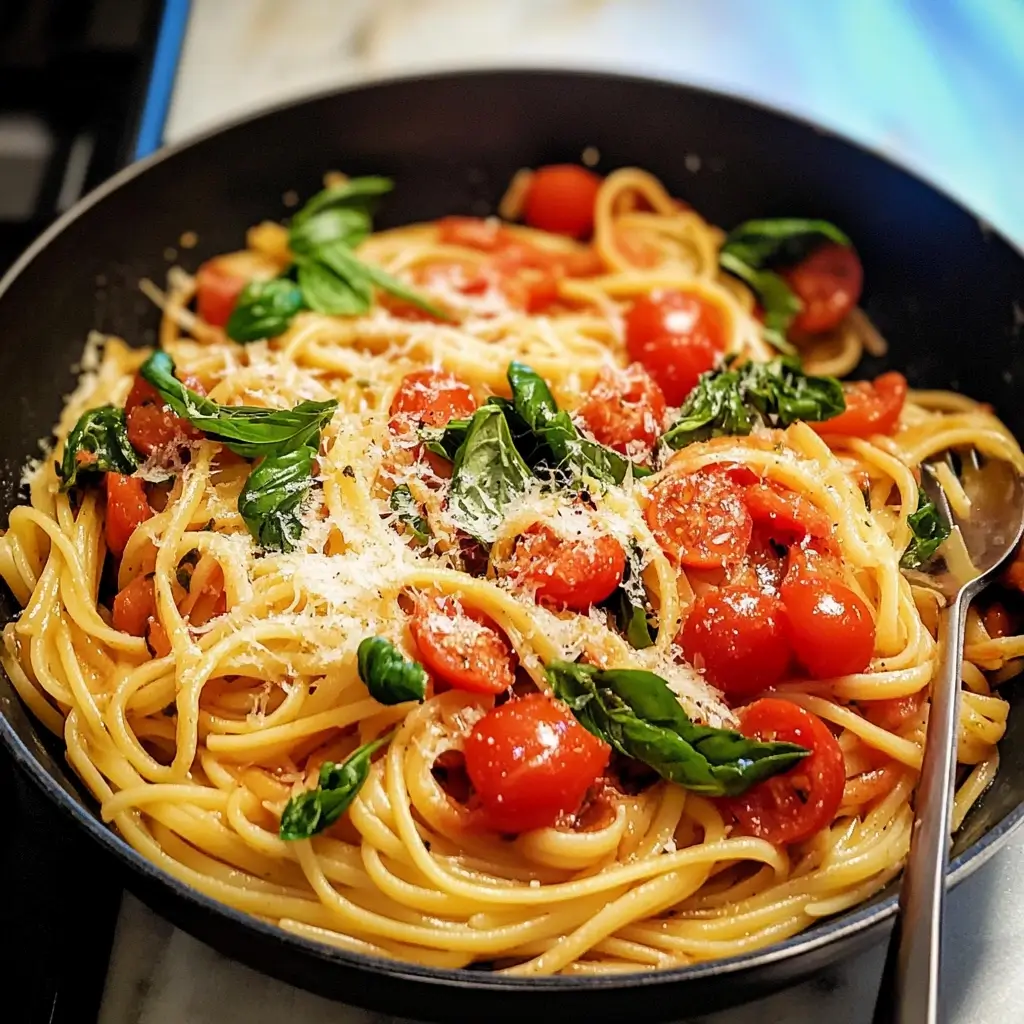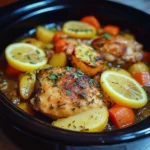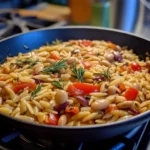There are some recipes that just feel like home, no matter where you are. For me, this Tomato Basil Pasta is one of those dishes. It’s the kind of meal that comes together in minutes, using ingredients you likely already have on hand, yet delivers a burst of fresh, vibrant flavor that’s simply irresistible. My family absolutely adores this pasta. Even on the busiest weeknights, when time is scarce and energy is low, I can whip up a batch of this comforting pasta and watch everyone devour it with gusto. The simplicity is the beauty – the sweet burst of cherry tomatoes, the fragrant basil, and the perfectly cooked pasta, all brought together with a drizzle of good olive oil. It’s a dish that proves you don’t need complicated techniques or fancy ingredients to create something truly special. The vibrant colors alone are enough to brighten any table, and the aroma that fills your kitchen while it cooks is pure magic. Honestly, if you’re looking for a reliable, crowd-pleasing, and incredibly easy pasta dish that’s perfect for any occasion, from a quick weeknight dinner to a casual weekend lunch, look no further. This Tomato Basil Pasta is about to become your new go-to.
Ingredients: The Soul of Simplicity
The beauty of this Tomato Basil Pasta lies in its short and sweet ingredient list. Each component plays a crucial role in creating the dish’s fresh and bright flavor profile. Let’s break down each ingredient and explore why it’s essential and how to choose the best quality for optimal taste.
- Pasta of Choice (8 ounces): This is where you get to personalize your pasta experience! The recipe is incredibly versatile and works wonderfully with a variety of pasta shapes.
- Spaghetti: A classic choice, spaghetti strands twirl beautifully with the tomato and basil sauce, offering a satisfying bite. Its long shape allows for ample sauce clinging, ensuring every forkful is flavorful.
- Penne: The ridged surface and hollow center of penne are perfect for capturing the chunky tomato sauce. Its sturdy shape holds up well and is great for scooping up all the delicious bits.
- Fusilli (Spirals): These corkscrew-shaped pasta are fantastic at trapping sauce in their twists and turns. They offer a fun texture and are particularly enjoyable for kids and adults alike.
- Farfalle (Bow Ties): Farfalle, with their charming bow tie shape, add a touch of elegance to the dish. Their textured surface and folds hold the sauce beautifully and provide a delightful chewiness.
- Rigatoni: For a heartier pasta experience, rigatoni’s wide tubes and ridged exterior are ideal. They are robust enough to stand up to a chunkier sauce and offer a satisfyingly substantial bite.
- Gluten-Free Options: If you’re gluten-free, don’t worry! There are fantastic gluten-free pasta options available made from brown rice, quinoa, corn, or lentil flour. Choose your favorite gluten-free pasta shape and enjoy this recipe without compromise.
- Cherry Tomatoes (2 cups, halved): Cherry tomatoes are the stars of this dish, bringing a burst of sweetness and acidity that perfectly complements the basil and pasta.
- Variety Matters: While any cherry tomato will work, consider exploring different varieties for nuanced flavor. Sungold tomatoes are incredibly sweet and almost candy-like. Sweet 100s are prolific and provide a classic tomato flavor. Black Cherry tomatoes offer a slightly richer, more complex taste. Mixing different colors and varieties can also add visual appeal to the dish.
- Ripeness is Key: Choose tomatoes that are firm, plump, and vibrantly colored. Avoid tomatoes that are bruised, soft, or have blemishes. Ripe tomatoes will be naturally sweeter and more flavorful.
- Halving for Flavor Release: Halving the cherry tomatoes is crucial as it allows their juices to release and mingle with the olive oil and seasonings as they warm through. This enhances the sauce and creates a more flavorful experience.
- Olive Oil (2 tablespoons): Olive oil is the foundation of this simple sauce, adding richness, flavor, and healthy fats.
- Extra Virgin Olive Oil (EVOO): For the best flavor and health benefits, always use extra virgin olive oil. EVOO is made from pure, cold-pressed olives and retains more of its natural flavors and antioxidants.
- Flavor Profile: Consider the flavor profile of your olive oil. Fruity and peppery olive oils will add a more pronounced flavor to the dish, while milder oils will allow the tomato and basil flavors to shine through. Experiment to find your preference!
- Quality Matters: Invest in a good quality olive oil. It makes a noticeable difference in the final flavor of the dish, especially in simple recipes like this where olive oil is a prominent ingredient.
- Fresh Basil Leaves (Generous handful): Fresh basil is the aromatic heart of this pasta, infusing it with its signature sweet, peppery, and slightly minty flavor.
- Fresh is Essential: Dried basil simply cannot compare to the vibrant flavor of fresh basil in this recipe. The fresh leaves release their essential oils when tossed with the warm pasta and tomatoes, creating an intoxicating aroma and flavor.
- Types of Basil: While sweet basil is the most common and widely used, consider exploring other basil varieties for subtle flavor variations. Genovese basil is a classic Italian basil with a strong, sweet aroma. Thai basil has a slightly anise-like flavor. Lemon basil offers a citrusy note.
- Adding Basil at the End: It’s crucial to add the fresh basil at the very end, just before serving. Cooking basil for too long can diminish its flavor and turn it brown. Tossing it in at the end preserves its bright green color and fresh, vibrant taste.
- Salt and Pepper (To Taste): Salt and pepper are the essential seasonings that enhance all the other flavors in the dish.
- Kosher Salt: Kosher salt is often preferred by chefs for its clean, pure flavor and larger crystals, which are easier to pinch and control.
- Freshly Ground Black Pepper: Freshly ground black pepper has a much more pungent and aromatic flavor than pre-ground pepper. Grind it just before using for the best taste.
- Seasoning to Taste: Don’t be afraid to season generously with salt and pepper. Taste the tomatoes and pasta mixture before adding the basil and adjust the seasoning as needed. Remember, salt enhances flavor, and pepper adds a subtle kick.
Instructions: Simplicity in Steps
This Tomato Basil Pasta is incredibly straightforward to make, perfect for even beginner cooks. Follow these simple steps for a delicious and satisfying meal in minutes:
- Cook the Pasta to Perfection: Start by bringing a large pot of salted water to a rolling boil. Salt is crucial for seasoning the pasta itself from the inside out. Use about 1-2 tablespoons of salt per gallon of water. Once boiling, add your chosen pasta and cook according to package directions. Crucially, cook the pasta al dente. This Italian term means “to the tooth,” indicating that the pasta should be cooked through but still firm to the bite, not mushy. Al dente pasta has a better texture and holds its shape better when mixed with sauce. Start checking for doneness a minute or two before the package directions suggest. To test, remove a strand of pasta and bite into it. It should be slightly firm in the center.
- Prepare the Tomato “Sauce” (Quickly!): While the pasta is cooking, prepare the simple tomato sauce. In a large pan or skillet (large enough to accommodate the cooked pasta later), heat the olive oil over medium heat. Allow the oil to heat gently; you’ll know it’s ready when it shimmers slightly. Add the halved cherry tomatoes to the pan. Season generously with salt and freshly ground black pepper. Don’t overcrowd the pan; if necessary, cook the tomatoes in batches to ensure they warm through evenly and don’t steam.
- Warm Through, Don’t Overcook: Cook the tomatoes, stirring occasionally, until they are warmed through and just beginning to soften. You want them to retain some of their shape and texture, not become completely mushy. This should take about 3-5 minutes, depending on the size and ripeness of your tomatoes. The goal is to gently heat them and allow their natural juices to release and mingle with the olive oil and seasonings, creating a light and flavorful “sauce.” Avoid overcooking the tomatoes, as they can become watery and lose their vibrant flavor.
- Combine Pasta and Tomatoes: Once the pasta is cooked al dente, drain it immediately, reserving about ½ cup of the pasta cooking water. Don’t rinse the pasta! Rinsing removes the starch that helps the sauce cling to the pasta. Add the drained pasta directly to the pan with the warmed tomatoes.
- Toss and Finish: Toss the pasta and tomatoes together gently to combine, ensuring the pasta is coated with the tomato “sauce.” If the mixture seems a bit dry, add a splash of the reserved pasta cooking water. The starchy water helps to emulsify the sauce and create a silky, glossy coating on the pasta. Remove the pan from the heat and immediately toss in the fresh basil leaves. The residual heat of the pasta and tomatoes will gently wilt the basil, releasing its fragrant aroma.
- Serve Immediately: Tomato Basil Pasta is best served immediately while it’s warm and the basil is fresh and vibrant. Portion the pasta into bowls and garnish with extra fresh basil leaves, a drizzle of olive oil, or a sprinkle of grated Parmesan cheese (optional, for those who enjoy cheese). Serve and enjoy the simple, fresh flavors of this delightful dish!
Nutrition Facts: A Light and Wholesome Meal
This Tomato Basil Pasta is not only delicious but also relatively light and wholesome, making it a great choice for a balanced meal. Please note that these are approximate values and can vary based on the specific ingredients used and portion sizes.
- Servings: Approximately 4 servings
- Calories Per Serving (Estimated): 400-500 calories (This can vary depending on pasta type, amount of olive oil, and added toppings)
Approximate Nutritional Breakdown Per Serving (Estimated):
- Protein: 10-15 grams (depending on pasta type)
- Fat: 15-20 grams (primarily from olive oil, healthy monounsaturated fats)
- Saturated Fat: 2-3 grams
- Cholesterol: 0 mg
- Sodium: Varies depending on salt added and pasta type
- Carbohydrates: 60-70 grams (primarily from pasta)
- Fiber: 5-7 grams (depending on pasta type and tomato content)
- Sugar: 5-8 grams (naturally occurring sugars from tomatoes)
Nutritional Highlights:
- Good Source of Carbohydrates: Pasta provides energy-sustaining carbohydrates. Choosing whole-wheat pasta will increase the fiber content.
- Source of Healthy Fats: Olive oil provides monounsaturated fats, which are beneficial for heart health.
- Rich in Vitamins and Antioxidants: Tomatoes are a good source of Vitamin C, Vitamin K, and lycopene, a powerful antioxidant. Basil also provides vitamins and antioxidants.
- Relatively Low in Saturated Fat and Cholesterol: This dish is naturally low in saturated fat and cholesterol, making it a healthier pasta option compared to cream-based sauces.
- Vegetarian and Vegan-Friendly (Naturally): This recipe is naturally vegetarian and vegan, making it suitable for a wide range of dietary preferences.
Note: To further enhance the nutritional value, consider using whole-wheat pasta, adding more vegetables like spinach or bell peppers to the tomato mixture, or incorporating a lean protein source like grilled chicken or chickpeas for a more complete meal.
Preparation Time: From Pantry to Plate in Minutes
One of the greatest appeals of this Tomato Basil Pasta is its incredibly quick preparation time. It’s a lifesaver for busy weeknights when you need a delicious and satisfying meal on the table fast.
- Prep Time: 5-10 minutes (This includes halving the tomatoes, gathering ingredients, and getting the water boiling)
- Cook Time: 15-20 minutes (This includes cooking the pasta and warming the tomatoes)
- Total Time: Approximately 20-30 minutes
Time Breakdown:
- Getting Started (5 minutes): Boil water for pasta, halve tomatoes, chop basil (optional – can tear basil later), gather olive oil, salt, and pepper.
- Pasta Cooking (8-12 minutes): Pasta cooks according to package directions.
- Tomato Warming (3-5 minutes): Tomatoes warm through in olive oil while pasta cooks.
- Combining and Finishing (2 minutes): Drain pasta, combine with tomatoes, add basil, and serve.
As you can see, from start to finish, this dish is ready in under 30 minutes, making it an ideal choice for a quick, healthy, and flavorful meal any day of the week.
How to Serve: Simple Elegance on Your Plate
Tomato Basil Pasta is delicious and versatile, perfect for a simple weeknight dinner or a casual gathering. Here are some serving suggestions to elevate your experience:
- Classic Simplicity:
- Serve immediately in bowls, garnished with extra fresh basil leaves.
- Offer a drizzle of high-quality extra virgin olive oil over each serving for added richness and flavor.
- A sprinkle of freshly grated Parmesan cheese (or nutritional yeast for vegan option) is a classic and delicious addition for those who enjoy cheese.
- Side Dish Pairings:
- Garlic Bread or Crusty Bread: Perfect for soaking up any leftover tomato sauce.
- Simple Green Salad: A light and refreshing salad with a vinaigrette dressing complements the pasta beautifully.
- Caprese Salad: Another tomato and basil combination, a Caprese salad with fresh mozzarella and balsamic glaze enhances the Italian flavors.
- Roasted Vegetables: Roasted asparagus, broccoli, or bell peppers add a healthy and flavorful side.
- Protein Additions (To make it a more substantial meal):
- Grilled Chicken or Shrimp: Sliced grilled chicken breast or sautéed shrimp adds protein and heartiness.
- Italian Sausage: Crumbled and browned Italian sausage (sweet or spicy) provides a richer flavor and protein boost.
- Chickpeas or White Beans: For a vegetarian protein source, add chickpeas or white beans to the tomato mixture while it’s warming.
- Tofu or Tempeh: Cubed and pan-fried or baked tofu or tempeh can be added for a vegan protein option.
- Make it a Pasta Bowl Bar:
- Set up a pasta bowl bar with bowls of Tomato Basil Pasta and various toppings for guests to customize their own bowls.
- Topping options could include: grilled chicken, shrimp, Italian sausage, chickpeas, roasted vegetables, different cheeses (Parmesan, mozzarella, feta), olives, sun-dried tomatoes, pesto, red pepper flakes.
- Serving Temperature:
- Serve warm immediately after cooking for the best flavor and texture.
- While it’s best fresh, leftovers can be enjoyed cold as a pasta salad the next day.
Additional Tips for Tomato Basil Pasta Perfection
Elevate your Tomato Basil Pasta from simple to sensational with these helpful tips:
- Use High-Quality Ingredients: As this recipe is so simple, the quality of your ingredients truly shines through. Invest in good quality pasta, extra virgin olive oil, and fresh, ripe cherry tomatoes and basil. The better the ingredients, the better the final dish will taste.
- Don’t Overcook the Pasta: Cooking pasta al dente is crucial for texture. Overcooked pasta becomes mushy and less appealing. Test your pasta for doneness a minute or two before the package directions suggest and drain it as soon as it’s al dente.
- Season Generously: Don’t be shy with the salt and pepper! Seasoning is key to bringing out the flavors of the tomatoes and basil. Taste and adjust seasoning as needed throughout the cooking process. Seasoning the pasta water is also important for flavorful pasta.
- Reserve Pasta Cooking Water: Always reserve some of the starchy pasta cooking water before draining. This liquid is a secret weapon for creating a silky, emulsified sauce. Adding a splash of pasta water to the tomato and pasta mixture helps to bind the sauce and create a glossy coating.
- Add a Touch of Garlic (Optional but Recommended): While the basic recipe is incredibly simple, adding a clove or two of minced garlic to the olive oil before adding the tomatoes can enhance the flavor depth. Sauté the garlic briefly until fragrant (about 30 seconds) before adding the tomatoes. Be careful not to burn the garlic.
Frequently Asked Questions (FAQ) – Tomato Basil Pasta
Q1: Can I use canned tomatoes instead of fresh cherry tomatoes?
A: While fresh cherry tomatoes are highly recommended for their sweetness and vibrant flavor, you can use canned diced tomatoes in a pinch. Drain the canned tomatoes well and consider roasting them briefly in the oven with olive oil, salt, and pepper before adding them to the pasta to concentrate their flavor. Fresh tomatoes will always yield a brighter and more flavorful result, especially in this simple dish.
Q2: Can I add other vegetables to this pasta?
A: Absolutely! This recipe is very adaptable. You can easily add other vegetables to enhance the nutritional value and flavor. Good options include:
- Spinach or Arugula: Wilted in with the tomatoes or tossed in at the end with the basil.
- Bell Peppers: Diced and sautéed with the tomatoes.
- Zucchini or Yellow Squash: Diced and sautéed with the tomatoes.
- Mushrooms: Sliced and sautéed with the tomatoes.
- Sun-dried Tomatoes: Add a more intense tomato flavor – rehydrate them in hot water or olive oil first.
Q3: Can I make this pasta ahead of time?
A: Tomato Basil Pasta is best enjoyed fresh, immediately after cooking, as the basil is most fragrant and vibrant then. However, you can prepare the tomato sauce ahead of time and store it in the refrigerator for up to 2 days. Cook the pasta fresh just before serving and toss it with the warmed sauce and fresh basil. Leftovers can be stored in the refrigerator for up to 2 days, but the pasta may absorb some of the sauce and become slightly softer. Reheat gently and add a fresh drizzle of olive oil and basil before serving.
Q4: Can I make this recipe spicy?
A: Yes! If you like a little heat, you can easily add some spice to this pasta. Here are a few options:
- Red Pepper Flakes: Add a pinch of red pepper flakes to the olive oil while heating, before adding the tomatoes.
- Fresh Chili: Finely chop a fresh chili pepper (like red chili or jalapeño) and sauté it with the garlic (if using) before adding the tomatoes.
- Pinch of Cayenne Pepper: Add a pinch of cayenne pepper to the tomato mixture for a subtle heat.
Start with a small amount and taste as you go, adding more spice to your preference.
Q5: What are some variations I can try?
A: This simple recipe is a fantastic base for many variations! Here are a few ideas to get you started:
- Tomato Basil Mozzarella Pasta: Add fresh mozzarella balls (bocconcini) or cubed mozzarella to the pasta along with the basil for a creamy and cheesy element.
- Pesto Tomato Basil Pasta: Stir in a spoonful or two of pesto (basil pesto or sun-dried tomato pesto) to the pasta for an extra layer of flavor.
- Ricotta Tomato Basil Pasta: Dollop creamy ricotta cheese on top of each serving for added richness and texture.
- Lemon Tomato Basil Pasta: Add a squeeze of fresh lemon juice and some lemon zest to the pasta at the end for a bright and citrusy twist.
- Garlic Breadcrumb Topping: Toast breadcrumbs with garlic and olive oil and sprinkle them over the pasta for added crunch and flavor.
Experiment with these variations and find your own perfect Tomato Basil Pasta creation! Enjoy!
Print
Delicious Tomato Basil Pasta Recipe
Ingredients
- Pasta of Choice (8 ounces): This is where you get to personalize your pasta experience! The recipe is incredibly versatile and works wonderfully with a variety of pasta shapes.
- Spaghetti: A classic choice, spaghetti strands twirl beautifully with the tomato and basil sauce, offering a satisfying bite. Its long shape allows for ample sauce clinging, ensuring every forkful is flavorful.
- Penne: The ridged surface and hollow center of penne are perfect for capturing the chunky tomato sauce. Its sturdy shape holds up well and is great for scooping up all the delicious bits.
- Fusilli (Spirals): These corkscrew-shaped pasta are fantastic at trapping sauce in their twists and turns. They offer a fun texture and are particularly enjoyable for kids and adults alike.
- Farfalle (Bow Ties): Farfalle, with their charming bow tie shape, add a touch of elegance to the dish. Their textured surface and folds hold the sauce beautifully and provide a delightful chewiness.
- Rigatoni: For a heartier pasta experience, rigatoni’s wide tubes and ridged exterior are ideal. They are robust enough to stand up to a chunkier sauce and offer a satisfyingly substantial bite.
- Gluten-Free Options: If you’re gluten-free, don’t worry! There are fantastic gluten-free pasta options available made from brown rice, quinoa, corn, or lentil flour. Choose your favorite gluten-free pasta shape and enjoy this recipe without compromise.
When selecting your pasta, opt for high-quality brands. Bronze-die pasta, in particular, often has a rougher texture that helps sauces cling better. Fresh pasta can also be used, but cooking times will be significantly shorter, so adjust accordingly.
- Cherry Tomatoes (2 cups, halved): Cherry tomatoes are the stars of this dish, bringing a burst of sweetness and acidity that perfectly complements the basil and pasta.
- Variety Matters: While any cherry tomato will work, consider exploring different varieties for nuanced flavor. Sungold tomatoes are incredibly sweet and almost candy-like. Sweet 100s are prolific and provide a classic tomato flavor. Black Cherry tomatoes offer a slightly richer, more complex taste. Mixing different colors and varieties can also add visual appeal to the dish.
- Ripeness is Key: Choose tomatoes that are firm, plump, and vibrantly colored. Avoid tomatoes that are bruised, soft, or have blemishes. Ripe tomatoes will be naturally sweeter and more flavorful.
- Halving for Flavor Release: Halving the cherry tomatoes is crucial as it allows their juices to release and mingle with the olive oil and seasonings as they warm through. This enhances the sauce and creates a more flavorful experience.
- Olive Oil (2 tablespoons): Olive oil is the foundation of this simple sauce, adding richness, flavor, and healthy fats.
- Extra Virgin Olive Oil (EVOO): For the best flavor and health benefits, always use extra virgin olive oil. EVOO is made from pure, cold-pressed olives and retains more of its natural flavors and antioxidants.
- Flavor Profile: Consider the flavor profile of your olive oil. Fruity and peppery olive oils will add a more pronounced flavor to the dish, while milder oils will allow the tomato and basil flavors to shine through. Experiment to find your preference!
- Quality Matters: Invest in a good quality olive oil. It makes a noticeable difference in the final flavor of the dish, especially in simple recipes like this where olive oil is a prominent ingredient.
- Fresh Basil Leaves (Generous handful): Fresh basil is the aromatic heart of this pasta, infusing it with its signature sweet, peppery, and slightly minty flavor.
- Fresh is Essential: Dried basil simply cannot compare to the vibrant flavor of fresh basil in this recipe. The fresh leaves release their essential oils when tossed with the warm pasta and tomatoes, creating an intoxicating aroma and flavor.
- Types of Basil: While sweet basil is the most common and widely used, consider exploring other basil varieties for subtle flavor variations. Genovese basil is a classic Italian basil with a strong, sweet aroma. Thai basil has a slightly anise-like flavor. Lemon basil offers a citrusy note.
- Adding Basil at the End: It’s crucial to add the fresh basil at the very end, just before serving. Cooking basil for too long can diminish its flavor and turn it brown. Tossing it in at the end preserves its bright green color and fresh, vibrant taste.
- Salt and Pepper (To Taste): Salt and pepper are the essential seasonings that enhance all the other flavors in the dish.
- Kosher Salt: Kosher salt is often preferred by chefs for its clean, pure flavor and larger crystals, which are easier to pinch and control.
- Freshly Ground Black Pepper: Freshly ground black pepper has a much more pungent and aromatic flavor than pre-ground pepper. Grind it just before using for the best taste.
- Seasoning to Taste: Don’t be afraid to season generously with salt and pepper. Taste the tomatoes and pasta mixture before adding the basil and adjust the seasoning as needed. Remember, salt enhances flavor, and pepper adds a subtle kick.
Instructions
- Cook the Pasta to Perfection: Start by bringing a large pot of salted water to a rolling boil. Salt is crucial for seasoning the pasta itself from the inside out. Use about 1-2 tablespoons of salt per gallon of water. Once boiling, add your chosen pasta and cook according to package directions. Crucially, cook the pasta al dente. This Italian term means “to the tooth,” indicating that the pasta should be cooked through but still firm to the bite, not mushy. Al dente pasta has a better texture and holds its shape better when mixed with sauce. Start checking for doneness a minute or two before the package directions suggest. To test, remove a strand of pasta and bite into it. It should be slightly firm in the center.
- Prepare the Tomato “Sauce” (Quickly!): While the pasta is cooking, prepare the simple tomato sauce. In a large pan or skillet (large enough to accommodate the cooked pasta later), heat the olive oil over medium heat. Allow the oil to heat gently; you’ll know it’s ready when it shimmers slightly. Add the halved cherry tomatoes to the pan. Season generously with salt and freshly ground black pepper. Don’t overcrowd the pan; if necessary, cook the tomatoes in batches to ensure they warm through evenly and don’t steam.
- Warm Through, Don’t Overcook: Cook the tomatoes, stirring occasionally, until they are warmed through and just beginning to soften. You want them to retain some of their shape and texture, not become completely mushy. This should take about 3-5 minutes, depending on the size and ripeness of your tomatoes. The goal is to gently heat them and allow their natural juices to release and mingle with the olive oil and seasonings, creating a light and flavorful “sauce.” Avoid overcooking the tomatoes, as they can become watery and lose their vibrant flavor.
- Combine Pasta and Tomatoes: Once the pasta is cooked al dente, drain it immediately, reserving about ½ cup of the pasta cooking water. Don’t rinse the pasta! Rinsing removes the starch that helps the sauce cling to the pasta. Add the drained pasta directly to the pan with the warmed tomatoes.
- Toss and Finish: Toss the pasta and tomatoes together gently to combine, ensuring the pasta is coated with the tomato “sauce.” If the mixture seems a bit dry, add a splash of the reserved pasta cooking water. The starchy water helps to emulsify the sauce and create a silky, glossy coating on the pasta. Remove the pan from the heat and immediately toss in the fresh basil leaves. The residual heat of the pasta and tomatoes will gently wilt the basil, releasing its fragrant aroma.
- Serve Immediately: Tomato Basil Pasta is best served immediately while it’s warm and the basil is fresh and vibrant. Portion the pasta into bowls and garnish with extra fresh basil leaves, a drizzle of olive oil, or a sprinkle of grated Parmesan cheese (optional, for those who enjoy cheese). Serve and enjoy the simple, fresh flavors of this delightful dish!
Nutrition
- Serving Size: One Normal Portion
- Calories: 400-500
- Sugar: 5-8 grams
- Fat: 15-20 grams
- Saturated Fat: 2-3 grams
- Carbohydrates: 60-70 grams
- Fiber: 5-7 grams
- Protein: 10-15 grams
- Cholesterol: 0 mg





